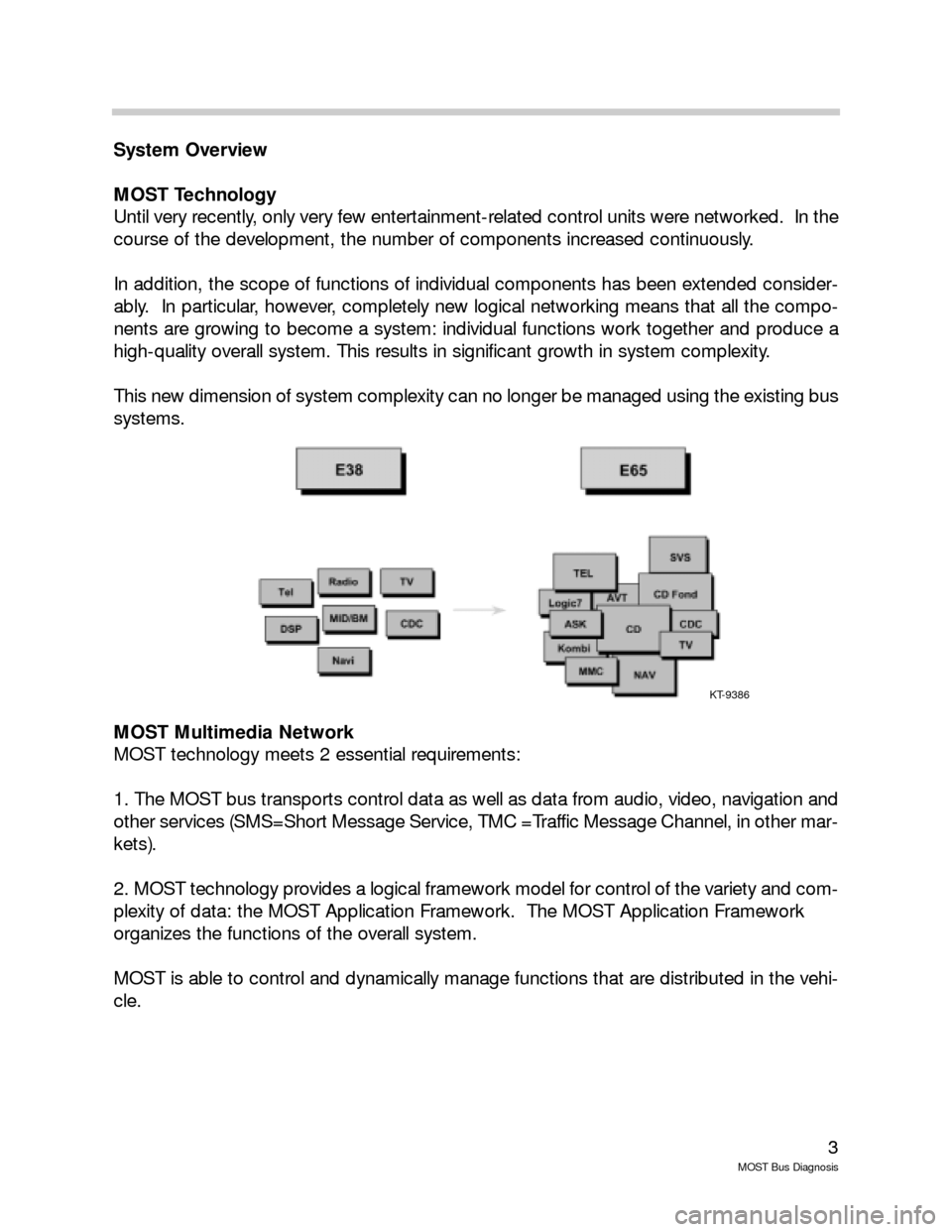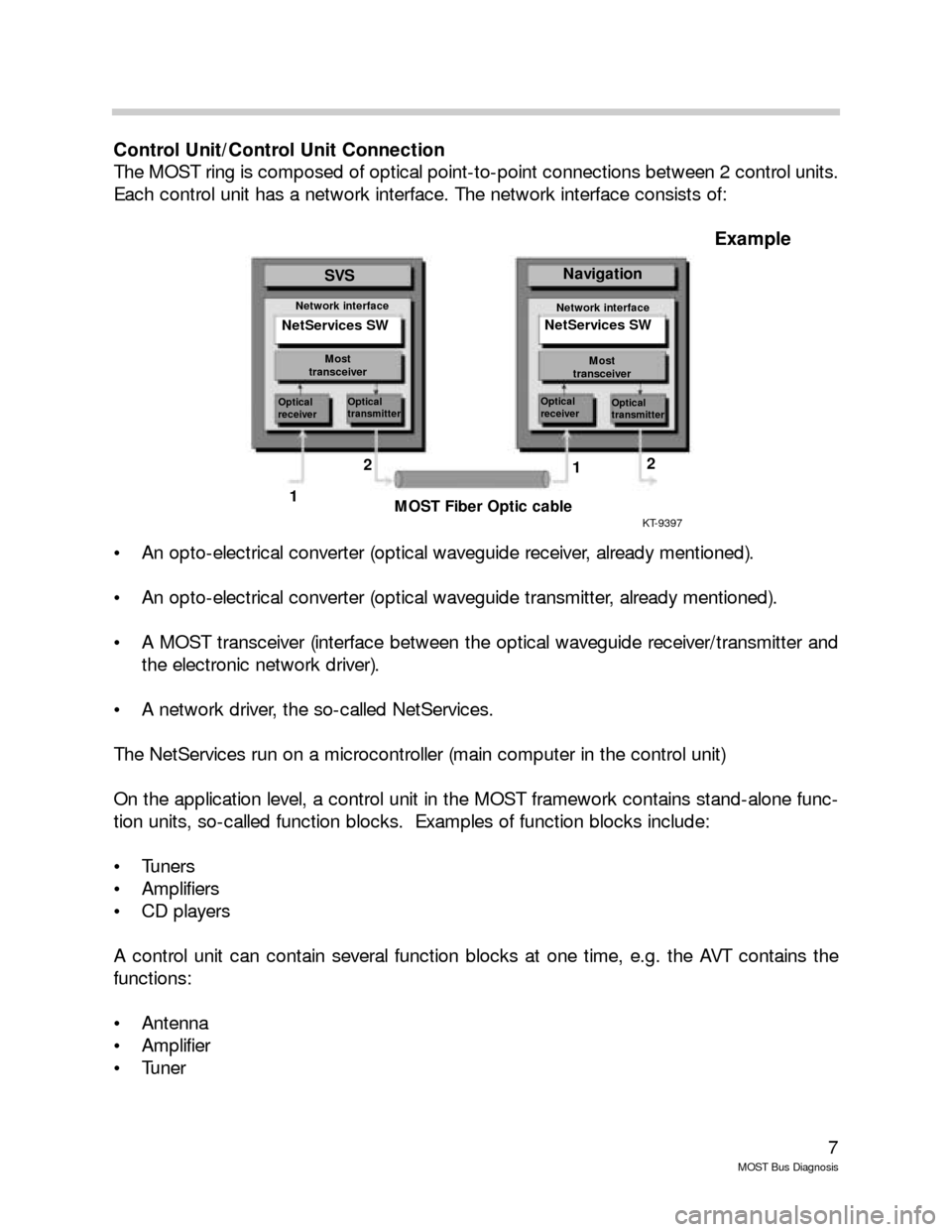service BMW 7 SERIES 2005 E65 MOST Bus Diagnosis Workshop Manual
[x] Cancel search | Manufacturer: BMW, Model Year: 2005, Model line: 7 SERIES, Model: BMW 7 SERIES 2005 E65Pages: 20, PDF Size: 0.13 MB
Page 3 of 20

3
MOST Bus Diagnosis
System Overview
MOST Technology
Until very recently, only very few entertainment-related control units were networked. In the
course of the development, the number of components increased continuously.
In addition, the scope of functions of individual components has been extended consider-
ably. In particular, however, completely new logical networking means that all the compo-
nents are growing to become a system: individual functions work together and produce a
high-quality overall system. This results in significant growth in system complexity.
This new dimension of system complexity can no longer be managed using the existing bus
systems.
MOST Multimedia Network
MOST technology meets 2 essential requirements:
1. The MOST bus transports control data as well as data from audio, video, navigation and
other services (SMS=Short Message Service, TMC =Traffic Message Channel, in other mar-
kets).
2. MOST technology provides a logical framework model for control of the variety and com-
plexity of data: the MOST Application Framework. The MOST Application Framework
organizes the functions of the overall system.
MOST is able to control and dynamically manage functions that are distributed in the vehi-
cle.
KT-9386
Page 4 of 20

4
MOST Bus Diagnosis
Principle of a Multimedia Network
An important feature of a multimedia network is that it transports not only control data and
sensor data, e.g. like the CAN bus and I bus (instrumentation bus). A multimedia network
can also carry digital audio and video signals and graphics as well as other data services.
Advantages of the Multimedia Network
All data can be transported across a shared network. This offers the following benefits:
Additional signal wiring harnesses are eliminated.
The only addition many control units need is the power supply.
As each participant (= each control unit) has access to all the
data, cost-intensive assemblies for signal distribution can be
eliminated.
Different data formats also have different requirements for transmission regarding both
mechanism (synchronous or asynchronous data) and the required band-width
(baud or bits/second). The MOST format is able to meet these requirements to a satisfac-
tory extent.
Audio
Video
RGB
Data Services
Control
KT-9387
Information transmitted on MOST network
Page 7 of 20

7
MOST Bus Diagnosis
Control Unit/Control Unit Connection
The MOST ring is composed of optical point-to-point connections between 2 control units.
Each control unit has a network interface. The network interface consists of:
An opto-electrical converter (optical waveguide receiver, already mentioned).
An opto-electrical converter (optical waveguide transmitter, already mentioned).
A MOST transceiver (interface between the optical waveguide receiver/transmitter and
the electronic network driver).
A network driver, the so-called NetServices.
The NetServices run on a microcontroller (main computer in the control unit)
On the application level, a control unit in the MOST framework contains stand-alone func-
tion units, so-called function blocks. Examples of function blocks include:
Tuners
Amplifiers
CD players
A control unit can contain several function blocks at one time, e.g. the AVT contains the
functions:
Antenna
Amplifier
Tuner
MOST Fiber Optic cable
Example
SVSNavigation
Network interface
Network interface
NetServices SWNetServices SW
Most
transceiverMost
transceiver
Optical
receiverOptical
receiver Optical
transmitterOptical
transmitter
KT-9397
1
1 22